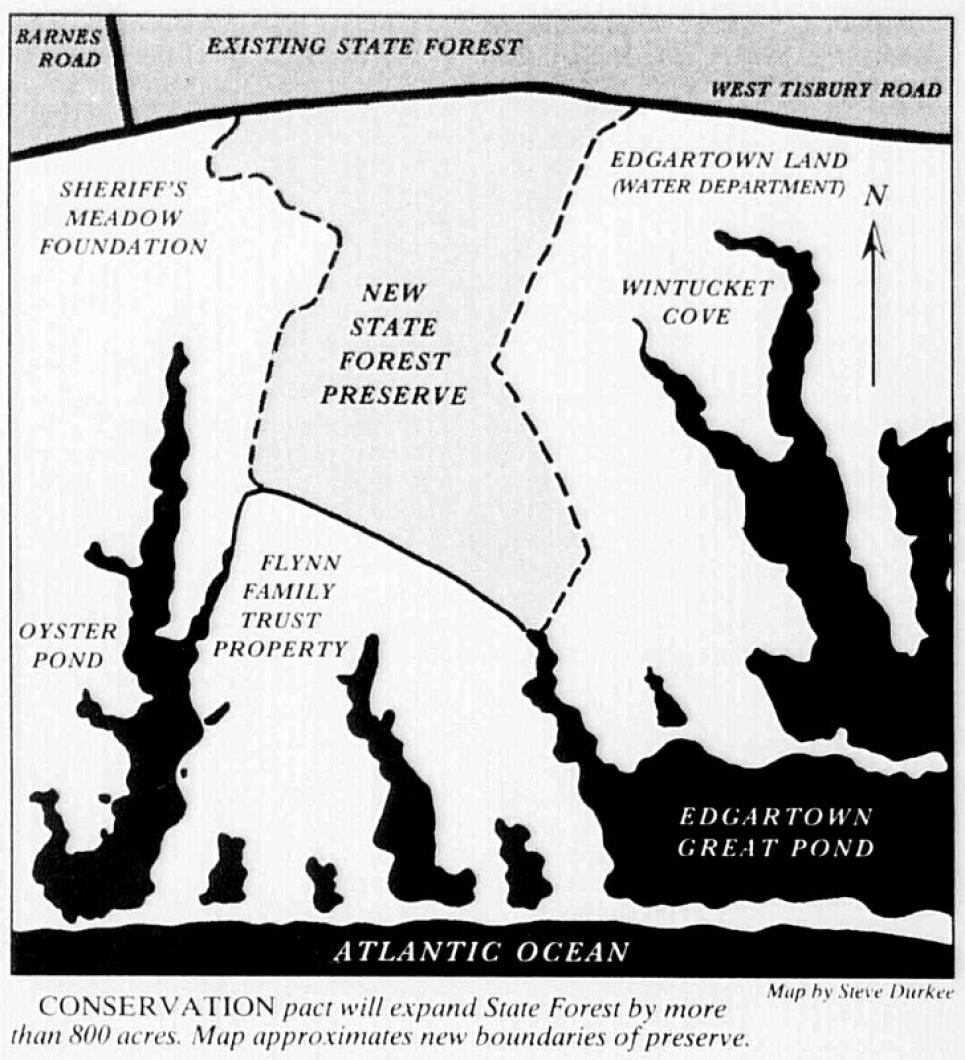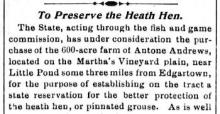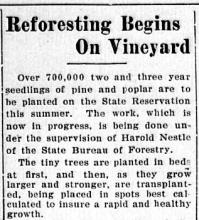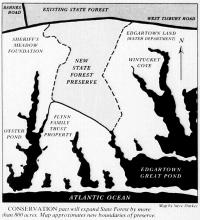Some 830 acres of unspoiled upland property in the rural perimeters of Edgartown - part of the vast place known to many as Pohogonot, whose total land area at one time included some 5,000 acres of magnificent upland and coastal farmland - will be sold by the descendants of the late George D. Flynn to the state Department of Environmental Management by the end of the month.
Once the purchase is complete, the property will be added to the Manuel F. Correllus State Forest, bringing the total size of the forest to more than 5,000 acres. The acquisition is believed to be the largest single conservation purchase by DEM this year. Purchase price will be $4 million, a price which is believed to be under the appraised value of the land.
The property runs along the south side of the West Tisbury Road and is bounded by the State Forest and also the secluded Oyster-Watcha compound. It also abuts the Wintucket land owned by the Edgartown Water Company and conservation land owned by the Sheriff’s Meadow Foundation. The land targeted for purchase by the state is all upland and includes no coastal or shorefront areas.
Funds for the purchase reportedly will come directly from the DEM budget. The property is currently owned by Eric Peters, trustee for the Elizabeth D. Flynn Trust, and the trustees of the Pohogonot Trust.
The property will be sold to the state in what is termed a friendly taking - essentially an eminent domain proceeding which is undertaken with the full cooperation and agreement of parties on both sides. The purchase is the result of negotiations which have been underway for some three years. No sale agreement has been signed yet, as state officials and the trustees for the Flynn family trust are still ironing out final terms, but the sale is expected to be complete before the end of the fiscal year on June 30 and may take lace as early as the coming week.
This week the matter came before the Edgartown selectmen for approval, as part of the procedure which accompanies a friendly taking.
The selectmen received a letter at the end of May from DEM commissioner Peter C. Webber describing the intended purchase. “The acquisition...presents a significant addition to state-owned land in this part of the Island,” wrote Mr. Webber. He also said eventual plans call for the property to be managed by the Nature Conservancy, a nationally renowned science-based conservation organization which has an office on the Vineyard and an increasing presence here.
Mr. Webber wrote: “We hope that the town will support our effort to acquire this property and bring it into the state’s system of protected open space. Doing so will allow us to undertake some of the exciting environmental initiatives contemplated by DEM and the Conservancy, and will protect and enhance the property’s unique ecological characteristics.”
The selectmen unanimously approved the purchase, with strong words of praise for both the Flynn family and the agencies involved in the purchase. “I think it is really a great thing and I have nothing but praise for the state, the Flynn family and also The Nature Conservancy for this purchase,“ said Fred B. Morgan Jr., chairman of the Edgartown selectmen. “I think it is great for the town and great for the whole Island,” he added.
The coastal sandplains of the Vineyard and Nantucket were named by The Nature Conservancy as one of the 40 Last Great Places on Earth in an unusual global conservation initiative two years ago. Once the purchase is complete, the property will become the largest piece of sandplain under single ownership in the entire region.
The property was once part of the grassy sandplains where sheep grazed and the now-extinct heath hen roamed, and the potential exists for the property to be returned to this more traditional historical landscape. Although no formal announcement has been made yet about uses for the property, it is expected that it will be made available for public recreational use in a manner similar to the present State Forest - including walking, bicycling and hunting.
The purchase was quietly hailed by many this week as extremely significant, even though no formal statements have been issued by any of the parties because the purchase agreement is still incomplete. Tom Chase, manager of the Vineyard, Nantucket and Elizabeth Islands bioreserve for The Nature Conservancy, deferred all comment to Mr. Peters, a local attorney and trustee for the Flynn Trust. Mr. Peters declined to comment; state environmental officials also issued only limited public comment.
“Basically we are optimistic but we cannot comment on any specifics and we are respecting the family’s wishes that we not make remarks in the press until we have an agreement signed,” said Susan Fairbanks, a public affairs spokesman for the DEM.
The Flynn family holdings at Pohogonot date back to the early 1900s; in 1903 George Daniel Flynn was injured in a train accident and was told by his doctor he needed a rest from the turmoil of Fall River. He found the perfect spot at the Crane House on the Love Smith shooting land at Pohogonot. Over the years the Flynn property has been used for sheep grazing, farming, hunting and fishing.
And although the land has been sold off in portions over the years, the family has always had a strong bent for preserving the land. Oyster-Watcha, Bold Water and Swan Neck are all limited subdivisions with a conservation theme.
When George D. Flynn Jr. put the first of his vast holdings on the market in the late 1970s, Henry Beetle Hough, the late editor of the Vineyard Gazette, wrote: “The effect on the Island of the breaking up of large properties such as those of Mr. Flynn is bound to be profound. These old properties were bound to b called ‘farms’ or ‘places’ but never ‘estates’ and they were not walled off in the manner of mainland estates. To some extent, from what seems time immemorial, they remained more or less open to the public, sometimes more freely than in other instances. They contributed immeasurably to the vistas and general scenery as viewed from roads or hills, and the ambiance they gave to the countryside has almost always been considered a part of the character and quality of the Island.
“This passing of the old, whether one considers it with nostalgia or not, has become inevitable...There are not only two horns of a dilemma, as between assessors and large property owners, but three horns, the last including the problem of a traditionally open Island with broad countrysides facing division and restriction dictated by economics and similar pressures.”











Comments